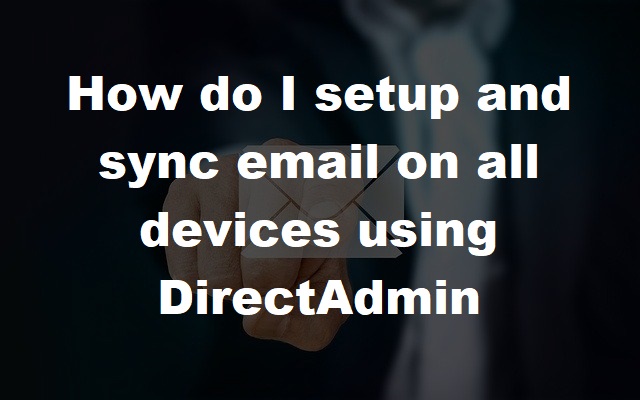How do I setup and sync email on all devices using DirectAdmin


If you're wanting to synchronise email we've created this blog just for you! Synchronising email is great to get to email regularly without having to manually login to your email all the time, it comes through automatically.
To receive mail with us, you'll need the following:
Once you have everything and you're ready to go we'll first need to create an email address, login into your hosting account, go to the email manager tab and select email accounts.
On the email account page you will see any accounts you create, select create account to make a new one. When choosing a password make sure it is secure and not easily recognised, you can also include numbers or symbols to make it stronger and harder to guess. Also make a note of the password if you can't remember it as we'll need it again to setup on other devices.
Now that you've setup your email you also have the option to make it more secure when sending and receiving emails, to do this once again within your hosting account we need to go to account manager then SSL certificates.
On the SSL certificates page select free and automatic certificate from Let's Encrypt, this will create a free SSL for you to use. On the next page tick the wildcard box and press save. The server will take several minutes to create your SSL and will send a confirmation to your email or within your hosting account in the messages section.
It's important to make a note of the ports that you can use when setting up any email, although within this guide we'll be setting up using a secure connection. known as IMAP (Internet Message Access Protocol). IMAP is also the more modern method of setting up email in comparison to POP3 (Post Office Protocol 3) which does not synchronise your emails with the server.
If you were to setup your account using POP3, any emails that you deleted on your device would not be deleted on the server. You would also need to login to your server emails directly to remove them, which is why IMAP is a much more popular option.
Servers also use SMTP (Simple Mail Transfer Protocol) for sending outgoing mail, another popular choice among many users. SMTP also relays outgoing mail between email senders and receivers.
Within your devices settings find email and choose other email, this will allow you to setup manually. Different devices differ between settings but we'll try and cover everything within the setup process, although they may not be in the same order.
Email:
Email that you created
Username:
Same as the email you created e.g. something@something.com
Password:
Password you made when creating the account
Incoming server
Choose IMAP server so that your email is synchronised.
IMAP server:
mail.yourdomain.com
Security type:
SSL
Port:
993
Outgoing server
All of your outgoing server settings
SMTP server:
mail@yourdomain.com
Security type:
SSL (Accept all certificates)
Port:
465
Require authentication to send emails:
Yes
Usually requires email and password to authenticate.
Your email should now be working correctly, if it is refusing to connect double check that your SSL is setup on your email and all ports and passwords are correct.
Looking for a reliable email hosting provider? Check out our Email hosting plans.